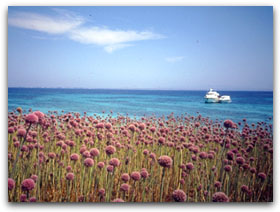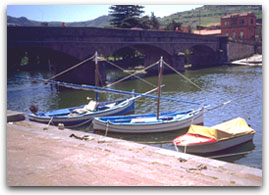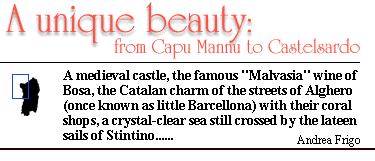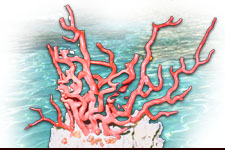Capo Mannu marks the end of the
wide bay of Cala Saline, which is in the province of Oristano. Along this stretch of coast, the
permanent winds and shallow waters, cause long high waves creating the ideal conditions for
sail boarding and surfing.
|
In front of Cala Saline there is the
small Island of Mal di Ventre, (which derives from the local language and means bad winds)
one of the most popular destinations for sailors in this area, who stop in one of the lees, to
swim in the clearest waters along this coast, or to try the delicious sea urchins or simply to
admire the island with its fauna and sweeping stretches of purple coloured wild garlic plants
that extend down to the shore.
|
|

 Mal di Ventre Mal di Ventre |

 Bosa - The mouth of
the river Temo Bosa - The mouth of
the river Temo |
|
After Capo Mannu there is the
marina of S.Caterina di Pitinnuri, where one can admire the huge calcareous rock face
called "S'Archittu" (little arch in the local language) because the sea has carved an arch
shaped tunnel into the cliff. Some miles northward, after the coast of Cuglieri (a wonderful
mountain village surrounded by olive groves and woods full of delicious mushrooms) and the
coast of Tresnuraghes one arrives at the small town of Bosa. It is built on the mouth of the
river Temo, which is the only navigable Sardinian river. It is navigable for about 9 Km.
|
The centre of
Bosa is clearly of Roman origin but its economic importance, which is connected to
its strategic position on the sea, dates from the XII century with the building of Castello di
Serravalle (surely the best mediaeval building in Sardinia), that overlooks Bosa, the river and
the surrounding area down to the sea. The mouth of the river is a
sheltered harbour for the numerous fishing boats who ply these waters (the lobster from
Bosa is in great demand because its meat is exquisite). On the left bank of the river there
is "Sas Conzas" which is an ancient tannery that is due for restoration.
|
|

 Il Castello di Bosa Il Castello di Bosa |
|



